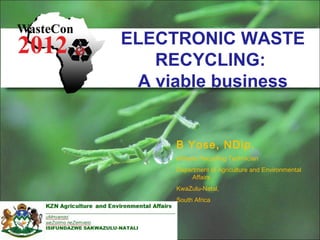Wastecon2012_Powerpoint_Presentation_Template_2
- 1. B Yose, NDip. eWaste Recycling Technician Department of Agriculture and Environmental Affairs KwaZulu-Natal, South Africa ELECTRONIC WASTE RECYCLING: A viable business
- 2. Scope Introduction Volumes of e-waste E-waste recycling as a formal business Recycling Standards Relevant Legislation Proposed Industry Plans Benefits of formalizing e-waste recycling Conclusion
- 3. Introduction What is e-waste? Broken/discarded electrical or electronic appliances Electrical appliances: Fridges, Stoves, etc Electronic appliances: Computers, Cellphones, etc Why the concern with e-waste management? Volume of e-waste Health concerns A viable business: Is there a need for it? Is there a potential market for it? Can it yield a profit?
- 4. E-waste volume Globally: 100 million computers in a population of 5.3 billion in 1990. 1 computer per 53 people. 1 billion computers in a population of 6.5 billion in 2005. 1 computer per 7 people 100 million computers were e-waste in 2004
- 5. E-waste volume South Africa: 4.5 million computers in a population of 46.9 million in 2005. 1 computer per 10 people. 5.3 million computers in a population of 47.4 million in 2006. 1 computer per 9 people 500 000 computers were e-waste in 2004 5.3 million computers can be assumed to be e-waste in 2012 20 % of computers imported in 2003 were e-waste from developed countries
- 6. South African e-waste Umsunduzi MunicipalityDept of Education (PMB) Museum (PMB) KZN Wildlife
- 7. E-waste recycling as a formal business Glass recycling business 5 workers Salaries = R8 000 Petrol = R1 800 Collected = 60 000kg Glass = R0.38/kg Income =0.38*60000 = R22 800 Profit = R13 000/month E-waste recycling business 5 (2) workers Salaries = R8 000(R3 600) Petrol = R1 800 Dismantled = 900 (180) computers Recyclables = 10 800 (4 320) kg per month Recyclables = R4.25/kg Income =4.25*10800(4320) = R45 900(R18 360) CRT disposal = R6 480 (R2 592) Profit = R29 620(R12 568)/month
- 8. E-waste recycling standards: Similarities: EHSMS Data destruction Transport Record keeping Differences: E-waste exportation Toxic e-waste disposal Toxic chemicals identification Responsible recycling (R2) practises vs e-Stewards standard
- 9. E-waste recycling standards eWASA technical guidelines Data destruction Transport Record keeping Disassembling processes
- 10. eWaste Recycling Manual Developed by KZN DAEA in 2012 Manual based on work done at Cedara eWaste recovery Facility from 2009 Lists PPE and Tools to use Disassembling main components Tower Monitor Keyboard Safety precautions Lists recyclables and hazardous components Contact details for district offices
- 11. Navigating the legislative environment Waste management license (WML) and / or Environmental Impact Assessment (EIA) Construction of facilities Storage of hazardous components of e- waste Atmospheric Emission license (AEL) Burning Effluent Trade Permit (Municipality) Production of liquid waste Second hand goods act (SAPS) Operating with second hand goods
- 12. Proposed industry waste management plans eWASA proposed industry waste management plan ITA proposed industry waste management plan NB: Dual income for recyclers from central bodies and dealers in both plans
- 13. E-waste recycling business benefits Saving landfill space Avoiding burying money Avoiding toxic contamination of our environment Protecting the informal e-waste recyclers from: Diseases such as cancer Glass implosion Electric shock
- 14. Conclusion Almost 6 million computers as e-waste An estimated profit of R29 620 per month Low numbers of landfill sites Toxic contamination Informal recycling
- 15. Thank you for your attention. Any questions? B Yose, NDip. eWaste Recycling Technician Department of Agriculture and Environmental Affairs KwaZulu-Natal, South Africa Tel: 033-343 8284 Email: babalwa.yose@kzndae.gov.za















